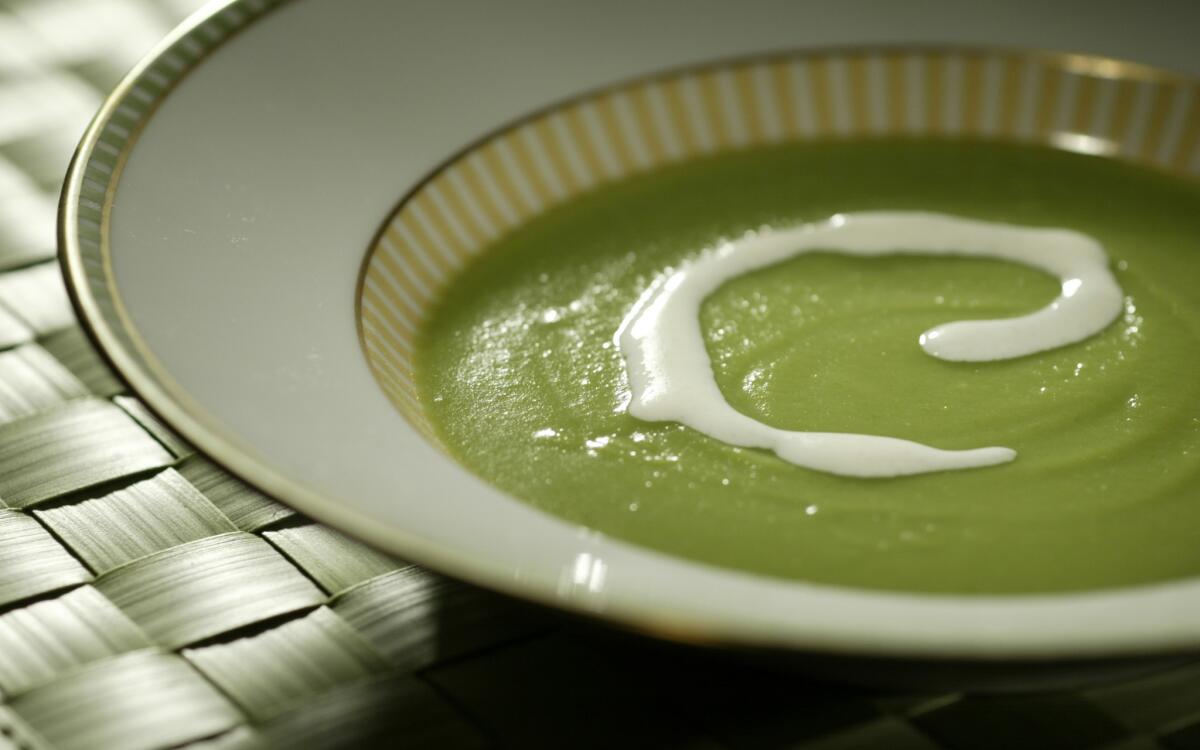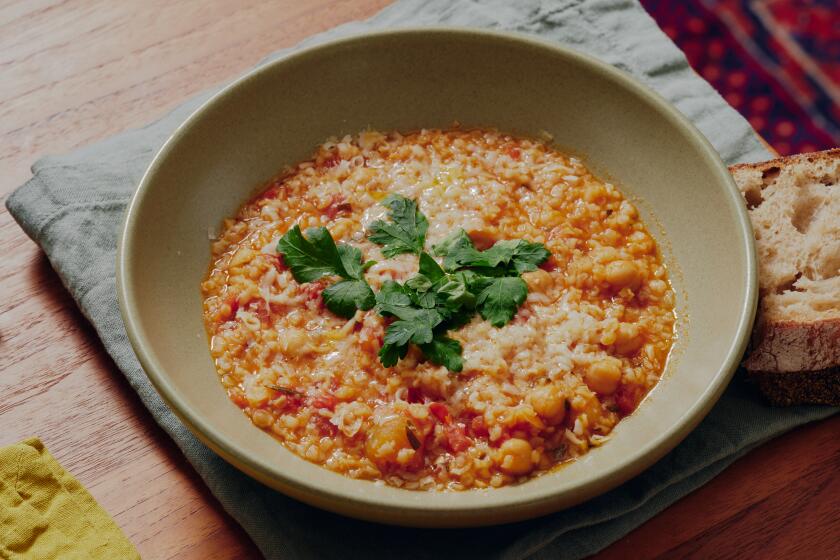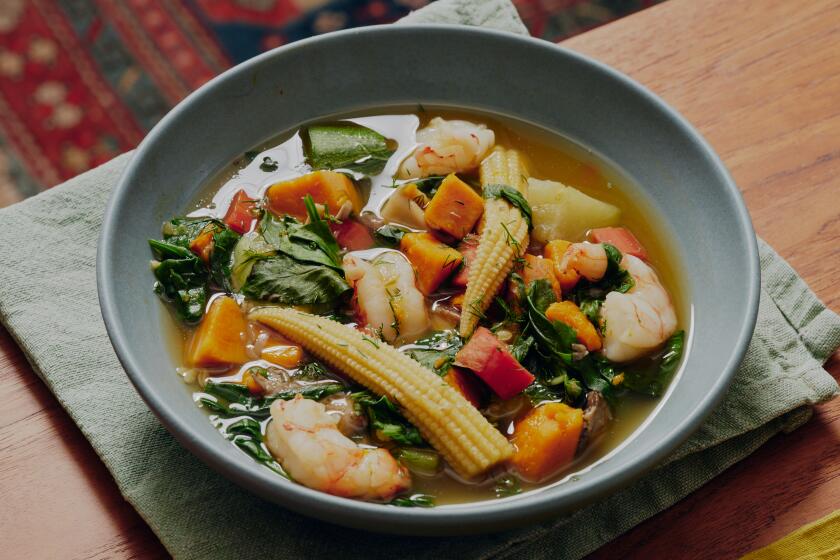Sugar snap pea soup with Parmesan cream

- Share via
Poets and gardeners agree that no flavor better captures spring’s sweet song than that of a perfect English pea. They may well be right, but most of us are just going to have to take their word for it.
A perfect pea is fleeting. Sweet and fresh one minute, it seems to tire and turn to starch the next. Shopping for peas is an exercise in frustration. Hidden away inside their pods, it’s almost impossible to tell whether you’re going to get a bright green diamond or just another lump of coal.
Rather than put yourself through another round of vegetable roulette, there is a better choice -- and one that is amazingly plentiful at this time of year.
The sugar snap pea captures all of the English pea’s charms, and adds a distinctive crunch as well. Best of all, it retains its sweetness and vitality long enough that you can actually get a chance to enjoy it.
Tables at local farmers markets are mounded with these little green gems, and they’re at all the supermarkets too. You still need to get there early to get the best of them -- sugar snap peas are hardly a secret.
The only problem is figuring out what to do with them. For years I’ve found sugar snap peas singularly exasperating to cook with. The problem is they’re so delicious raw -- so bursting with that sweet green vitality -- that it seemed like cooking could only diminish them.
And so I’d keep things very simple: blanch them briefly to brighten the color, then dress them lightly with a little butter and some coarse salt; or maybe I’d combine them with herbal mayonnaise and quickly cooked shrimp for a spring salad, or something like that.
There’s certainly nothing wrong with either of these treatments, but last week I got the urge to do a little more. And it turns out the answer was right in front of my face: Sugar snaps have all the sweetness and verdant flavor of English peas, so why not adapt some traditional pea recipes using them?
Sometimes that kind of cook’s logic can lead to disaster (I still cringe at the memory of a sauteed chicken coated in a thick paste of ground black olives). But in this case it worked like a charm.
Pureed, the sugar snaps make a splendid stand-in for peas in a vividly green light spring soup. And it’s so much less labor-intensive and more cost-effective than the original, since you use the entire pod.
Left whole and steamed briefly in lettuce leaves, their flavor picks up added notes of complexity. And cut into pieces and stirred into a prosciutto-based risotto, they add a surprising crunch to what is really a souped-up risi e bisi.
For those who despair that modern agricultural improvement is an oxymoron, sugar snaps offer reassurance that sometimes things do go right.
Though they are so familiar today that they seem to have been around forever, sugar snap peas are a fairly recent crossbreeding that combines the best features of two other varieties -- sugar peas (another name for snow peas) and snap peas (another name for the English pea).
They have the edible pod of the snow pea, and the swollen seed, thick hull and surpassing sugar of the English pea. The biggest difference between the sugar snap and the traditional pea is that its succulent hull is remarkably high in sugar and low in fiber. Eat an English pea pod and you’ll wind up with a mouth full of string. Eat a sugar snap pod and all you’ll get is a smile.
Edible-pod peas have been around for ages -- they are mentioned in 18th century gardening texts. But they had fallen out of favor in this country by the start of the 20th century, only to be re-introduced in the foodie ‘70s -- snow peas by a thousand Chinese restaurants, and sugar snaps by the enthusiastic marketing of a plant breeder named Calvin Lamborn.
Lamborn was trying to improve an existing snow pea variety and had the bright idea to cross it with a “sport” English pea plant that had formed very hard, tightly sealed walls. His new plant, introduced in 1979, was immediately honored with a gold medal from the All-American Selection committee.
Lamborn’s invention has become so successful that “sugar snap pea,” which originally applied only to his specific variety, has become so widely used as to be almost generic. The sugar snap has become the Xerox of edible-pod peas.
Though sugar snaps and other peas make incomparable poetic metaphors for spring, their real connection to the season is more prosaic. Pea plants thrive in cool weather and are fast growing. And, like all legumes, they add nitrogen to the soil. So you sow your seeds in January and by early March you’ll have sugar snaps by the ton. And then you can plant your summer crop on improved land. Choosing sugar snap peas at the farmers market is almost foolproof; there are so many you can just wander from stand to stand tasting. Pick the ones that are firm and crisp with no sign of wilting or softening. The pods should be well filled out, but not so much that the individual peas are popping open the hull. Sugar snaps frequently have small white scars on their shells; this is nothing to worry about.
The main concerns are keeping them cold and keeping them dry. Sugar snaps lose their freshness fast -- in post-harvest technology lingo, they have high respiration rates -- but cooling slows it. Moisture is another great enemy as it quickly breaks down the pea’s hull.
Some varieties of sugar snaps are stringless; I haven’t noticed any difference in flavor between these and others. In fact, it’s darned hard to tell which is which. The only way to find out for sure is to try one.
If yours need stringing, it’s easy to do: Bend back the stem end until it snaps, then gently pull away the string that runs the length of the pod like a zipper (some sugar snaps, it seems to me, are even double-stringed -- but if you’re careful, you can remove both at the same time).
When cooking sugar snaps, concentrate on brevity. You’ll want to preserve that lovely crispness, which fades after five or six minutes. Color is the other risk factor -- sugar snap peas begin to turn from verdant green to olive drab if cooked morethan seven or eight minutes.
Most of the time, you won’t need to worry about this. In the risotto, for example, the snap peas are stirred in after the last addition of stock. They cook for only three or four minutes before you remove the pan from the heat and beat in the butter, chives and cheese. This way you get both the green color you’d get from English peas and a distinctive crunch as well, which is an intriguing counterpoint to the soft, almost soupy rice.
Steaming snap peas in lettuce leaves is even simpler. All you’re trying to do here is brighten the color, soften the minced shallots a little, and tenderize the pea pods just enough that they’ll absorb some of the flavors.
They should be nearly raw, with that perfect crisp-moist texture you don’t really get from anything else. Discard the lettuce leaves; they’re just there to cushion the heat and provide a little of their green herbal flavor.
The only tricky bit of timing comes with the pureed soup, but the finished dish is so lovely and vividly flavored you won’t mind. Boil the peas long enough that they are thoroughly softened, but not so long that the color fades. This should take no longer than six to eight minutes. First, cover the pot with a lid to quickly return the water to a boil, then keep a close eye on the peas: As soon as the first one starts to go drab, drain them and immediately plunge them into an ice water bath to stop the cooking.
Puree the peas -- pods and all -- in a blender, adding only enough stock to get things moving. If yours have strings, remove those before cooking, as they’ll gum up the works. This first step will make a thick puree that can be used as a side dish. It will thin after the first straining but you’ll still need to stir in some stock to get the right consistency.
Strain it a second time through a fine mesh and you’ll have a soup of surpassing silkiness, a vivid emerald in color, with a sweet, clean, slightly herbal flavor. Pour it in a wide bowl and swirl in a splash of nutty, ivory-colored Parmesan cream for contrast.
And then call your favorite poet, or gardener, and tell them dinner’s ready.
In a large pot of rapidly boiling, generously salted water, add the sugar snap peas. Cover the pot and bring back to a boil. Uncover and cook until the peas are tender but still a vibrant green, 6 to 8 minutes. Do not cook so long that they turn drab. As soon as the peas are done, drain them and place them in an ice water bath to stop the cooking and preserve their bright color. Drain them again.
While the peas are cooking, cook the shallots in 1 tablespoon of butter in a small skillet over medium-low heat until the shallots are tender and translucent, about 5 minutes. Set aside.
Place half of the peas in a blender and puree until very smooth. Add a tablespoon or two of chicken stock, if necessary, to keep the mixture flowing. Add the remaining peas and the cooked shallots and finish pureeing.
Pass the pea puree through a strainer into a bowl, pressing with the flat rubber spatula to work it all through. Rinse the spatula blade to remove any fiber and scrape the thick pea puree that sticks to the outside of the strainer into the bowl. Discard the fiber that is left behind inside the strainer.
Stir in just enough chicken stock into the puree to make it a flowing liquid. It should have the consistency of fairly thin split pea soup. Stir in the salt, a few gratings of nutmeg and lemon juice. Taste, and if the peas aren’t bright and sweet, stir in enough sugar to correct. If necessary, add more salt and lemon juice as well. The recipe can be prepared to this point up to 8 hours in advance (any longer and the color will start to fade). Refrigerate in a tightly covered container.
Pass the puree through the finest strainer you have into a saucepan. Warm over medium-low heat until the mixture is bubbling. While the puree is warming, cook the cream and Parmesan in a small saucepan over medium heat just until the Parmesan melts and the cream is thick enough to coat the back of a spoon.
When the puree is hot, stir in the remaining 1 tablespoon of butter. Taste once more and adjust the seasoning if needed. Divide evenly among 6 warmed soup plates. Gently shake each plate to distribute the puree in an even layer. Spoon some of the Parmesan cream into the center of the puree in a rough “C” pattern. Serve immediately.
Get our Cooking newsletter.
Your roundup of inspiring recipes and kitchen tricks.
You may occasionally receive promotional content from the Los Angeles Times.
















